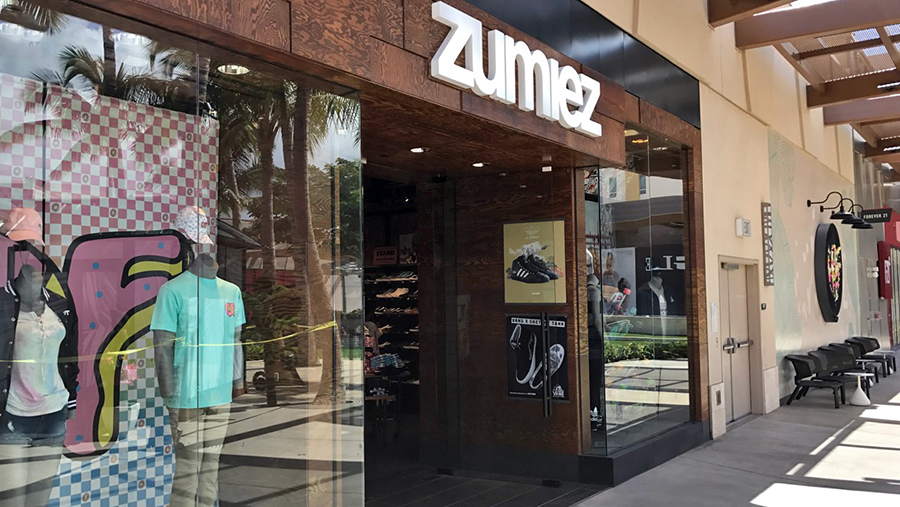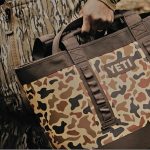Zumiez, Inc. CEO Rick Brooks saw the retailer’s first quarter performance as an encouraging start to 2024 despite posting a decline in sales and a decline in sales and net loss for the period. The positive reaction came from the fact that both sales and EPS were above the high end of the company’s guidance range. Brooks said this showed continued improvement in year-over-year trends and demonstrated progress in positioning the business for growth.
On a conference call with analysts after reporting results on June 6, Brooks noted that first-quarter top-line results were driven by North America as comparable sales for the region inflected to the positive.
“This performance was led by our Men’s business, which was up year-over-year for the second consecutive quarter after accelerating from its positive finish to fiscal 2023,” he said. “Our Women’s business also contributed to sales performance turning positive for the quarter. As expected, Hardgoods remained under pressure. Giving back some on Quarter 4’s improvement, as we exited the snow season.”
Overall, Zumiez posted increases in average unit retail and units per transaction for the first three months of fiscal 2024, offset by a decline in transactions.
Company CFO Chris Work said that first-quarter net sales were $177.4 million, down 3 percent from $182.9 million in the first quarter of 2023. Comparable sales were down 2.4 percent for the quarter.
“As Rick mentioned, our North America business comparable sales were up year-over-year, marking the first time we’ve seen growth in the region since 2021,” added Work. “This was offset by a decline in international sales, as we put greater emphasis on full-price selling in Europe, which benefited margins but pressured our top-line revenue.”
From a regional perspective, North America net sales were $142.7 million, a decrease of 0.9 percent from 2023. Other International net sales, which include Europe and Australia, were $34.7 million, a decline of 10.8 percent from last year.
Excluding the impact of foreign currency translation, North America net sales reportedly decreased 0.9 percent and Other International net sales decreased 10.6 percent year-over-year.
Comparable sales for North America were up 0.3 percent and comparable sales for Other International were down 13 percent for the quarter.
From a category perspective, Men’s was said to be the largest positive comping category, followed by Women’s. Hardgoods was said to be the largest negative comping category, followed by Accessories and Footwear.
Work said the consolidated decrease in comparable sales was driven by a decrease in transactions, partially offset by an increase in dollars per transaction.
“Dollars per transaction were up for the quarter, driven by an increase in average unit retail and an increase in units per transaction,” The CFO detailed.
First quarter gross profit was $51.9 million, compared to $49.4 million in the first quarter of last year.
Gross profit as a percentage of sales was 29.3 percent for the quarter, compared with 27 percent in the first quarter of 2023. According to Brooks, merchandising margins saw an improvement year-over-year and came in ahead of quarterly guidance as a heightened focus on driving full-price selling in Europe fueled consolidated core product margin growth.
The 230-basis-point increase in gross margin was said to be primarily driven by an improvement of 70 basis points in product margin, 70 basis points of leverage in shipping costs, 20 basis points of leverage in distribution center costs, 20 basis points of leverage in store occupancy costs, and a benefit of 60 basis points related to a mix shift away from service and related shipping revenue in the prior year’s Q1 results, which carried a negative margin during the prior-year quarter.
SG&A expense was $72.1 million, or 40.6 percent of net sales, in the first quarter, compared to $70.7 million, or 38.7 percent of net sales, in the year-ago Q1 period. The 190-basis-point increase in SG&A expenses as a percent of net sales resulted from a 60-basis-point increase in annual incentive compensation, 50 basis points due to timing of employee training that is expected to be a benefit in the second quarter, 50 basis points due to non-store wages and 40 basis points due to store wages tied to both deleverage on lower sales, as well as wage rate increases, according to commentary from CFO Work.
Operating loss in the first quarter was $20.2 million, or negative 11.4 percent of net sales, compared with an operating loss of $21.4 million, or negative 11.7 percent of net sales, in Q1 last year.
Net loss for the first quarter was $16.8 million, compared to a net loss of $18.4 million for the first quarter of 2023.
The effective tax rate for the first quarter of 2024 was a 14.4 percent benefit compared with a 12.6 percent benefit in the year ago period.
“Our first quarter results are a further indication that we are progressing towards positive comparable sales and improved profitability,” said Brooks. “That said, we recognize that we still have a considerable amount of work ahead of us to achieve both the levels of top-line revenue and bottom-line profitability that we expect from the business. As we continue to navigate a challenging retail environment, we stay focused on items within our control to grow sales and drive the business back to its historical operating performance and beyond.”
Brooks reminded everyone that the company is focused on several key strategies.
“First, we are concentrated on reinvigorating our top-line through investments to ensure we continue to win with consumers,” he outlined. “Some of these initiatives include infusing our product assortments with fresh offerings. We launched over 100 brands in 2022 and over 150 brands in 2023, with plans to launch similar levels in 2024. We are already seeing our newly launched brands in the past couple of years, accounting for a larger portion of current sales than we have seen historically, indicating they are resonating well with our customers.”
Brooks said the company is also expanding its Private Label brand portfolio this year.
“Private Label represented approximately 23 percent of sales in 2023, up from 18 percent in 2022 and 13 percent in 2021,” he detailed. “This growth showcases our team’s ability to capitalize on both trend and value-conscious consumers, providing another avenue for growth.”
He also said the company is maintaining its “best-in-class service” in stores and online with continued investment in training and technology.
“Combined, these efforts aim to enhance our customer relationships and engage with them in more personalized and relevant ways,” he said.
“Along with these new top-line initiatives, we are enhancing our focus on profitability, both in Europe and in North America,” Brooks noted. “In Europe, our plan involves a pivot from our growth strategy. We have slowed store expansion this year, and instead we’ll focus on enhancing the productivity of nearly 90 stores across nine countries and our pan-European web business currently serving the European market. With a focus on full-price selling for our existing footprint, we believe we can unlock the potential for the business and create value as we work through what has been a difficult cycle in Europe.”
Brooks said there is no doubt that trends emerge locally and grow globally, and the company’s penetration of the relevant markets is a significant advantage to Zumiez over the long-term.
“Overall, we believe we can achieve profitability in Europe with this new focus as we have done in other international markets like Canada and Australia. Beyond Europe, we are focused on profitability in other markets as well,” he said. “In 2023, we closed 18 underperforming North American stores and expect to close an additional 20 to 25 locations in 2024.”
Brooks shared that Zumiez decreased field and corporate staffing levels to align with the reduced store count.
“We are also further optimizing store labor through several initiatives, including adjustments to staffing models at lower volume stores,” he said. “We have made structural changes with shipping and logistic costs company-wide, reduced discount selling compared with last year’s elevated levels and continue to implement other cost-saving opportunities in many areas throughout the organization.”
While Brooks admitted that Zumiez would not be able to improve earnings on negative sales results over the long term, it is a combination of these initiatives that helped the retailer narrow its net loss in the first quarter despite the sales decline.
“This helped drive the overall improvement on our bottom-line results despite our sales decline to a loss of 86 cents per share compared to a loss of 96 cents per share last year,” he suggested, noting that the result for the quarter was “meaningfully better” than their guidance of a loss of $1.09 to $1.19 per share.
“Overall, these adjustments in our operating strategy, combined with our strong balance sheet with more than $145 million in cash, position us well to navigate the current environment and emerge a stronger and more profitable company,” Brooks said.
Balance Sheet
“We had cash and current marketable securities of $146.6 million as of May 4, 2024, compared to $155.3 million as of April 29, 2023,” Work detailed. “The $8.7 million decrease in cash and current marketable securities over the trailing 12 months was driven primarily by capital expenditures of $17.5 million offset by $9.1 million in cash provided by operating activities.”
As of May 4, 2024, ZUMZ had no debt on the balance sheet.
On June 5, 2024, the Board approved repurchasing up to $25 million of common stock. The repurchase program is expected to continue through June 30, 2025, unless the Board of Directors extends or shortens the period.
Zumiez ended the quarter with $146.8 million in inventory, down 0.7 percent compared with $147.9 million last year. “On a constant-currency basis, our inventory levels were down 0.1 percent from last year,” Work said.
“Given the sales backdrop, we are happy with our ending inventory balance for the first quarter and I expect to continue to bring in newness, as we move into the important back-to-school season and throughout 2024,” the CFO said.
Second Quarter
Net sales for the four-week fiscal May period ended June 1 increased 1.8 percent compared to the four-week period ended May 27, 2023. Comparable sales for the four-week fiscal May period this year were down 0.2 percent from the prior-year comparable period.
“From a regional perspective, net sales for our North America business for the four weeks ended June 1, 2024, increased 2.5 percent compared to the four-week period ended May 27, 2023, while our Other International business decreased 1.1 percent,” Work detailed.
Excluding the impact of foreign currency translation, North America net sales for the four-week fiscal May period increased 2.6 percent from the prior-year comparative period, while Other International net sales decreased 0.4 percent compared with fiscal May 2023.
Comparable sales for North America increased 1.5 percent year-over-year for the four-week May period, while comparable sales for the Other International business declined 7.3 percent year-over-year.
From a category perspective, in fiscal May 2024, Men’s was said to be the largest positive comparable sales growth category, followed by Women’s. The Accessories category was the largest decliner in comparable sales, followed by Hardgoods and Footwear.
Work said the comparable sales decrease was driven by a decrease in transactions, partially offset by an increase in dollars per transaction. Dollars per transaction reportedly increased for the four-week period due to an increase in average unit retail and an increase in units per transaction.
“With respect to our outlook for the second quarter of fiscal 2023, I want to remind everyone that formulating our guidance involves some inherent uncertainty and complexity in estimated sales, product margin, and earnings growth, given the variety of internal and external factors that impact our performance,” the CFO cautioned.
He said Zumiez is anticipating total sales for the second quarter to range between $199 million and $204 million, or a 2.5 percent to 5.0 percent sales increase.
“The second quarter will benefit from the calendar shift, which will pull one week of heavier back-to-school volume into the second quarter and out of the third quarter,” Work noted. “Adjusting for this shift, we are estimating second-quarter sales to be negative low-single-digits to flat for the quarter when compared to the same week in the prior year.
He said second quarter 2024 product margins will be slightly positive.
Consolidated operating loss as a percent of sales for the second quarter is expected to be between negative 4.5 percent and negative 3.0 percent and the anticipated loss per share will range between 30 cents and 40 cents, compared to a loss of 44 cents in the prior-year Q2 period.
Full Year 2024
“As we consider the full-year outlook, we still believe there to be uncertainty and volatility in the macro environment,” Work cautioned. “Given this, we will refrain from giving specific financial guidance but do want to share our expectations for the year that are unchanged from our March release earlier this year. We have experienced several negative sales trends over the past two years, driven by the pandemic, inflation, competition for the discretionary dollar, negative brand trends and general global instability.
“Given the magnitude of the multiyear decline, we believe that we’re beginning to see the impact of those negative business trends moderate, and our current results are showing that new trends are taking hold,” he continued. “This includes our Men’s category being positive across the last two quarters and our Women’s category turning positive in the first quarter. At this time, we believe we can build upon these trends throughout 2024 and see total sales growth for the full year.”
After two years of difficult performance in product margin, Work said they believe that with a more stable sales environment, they will grow product margin in 2024.
“With sales growth in 2024, we anticipate that we’ll leverage SG&A costs year-over-year beyond the benefit we will receive of moving past the $41.1 million goodwill impairment charge we recorded in the fourth quarter of 2023,” he said. “With the previously mentioned assumptions, we believe we will return to positive operating margins for the full year; while effective tax rates are likely to fluctuate significantly by quarter, we anticipate that our full-year effective tax rate will be roughly 47 percent in fiscal 2024.”
Zumiez is planning to open ten new stores during the year, including three in North America, three in Europe and four stores in Australia, down from 19 stores in 2023 and 32 in 2022, as the company focused on optimizing its current footprint.
Work said the company plans to close approximately 20 to 25 stores in fiscal 2024, with most of the closures in North America. The number of closures could go up or down, depending on the operating results in each location, as well as the company’s ability to work with its landlord partners
Capital expenditures for 2024 are forecast between $14 million and $16 million, compared to $20.4 million in fiscal 2023 and $25.6 million in fiscal 2022. Work said the reduction is primarily due to fewer planned store openings.
“We expect that depreciation and amortization, excluding non-cash lease expense, will be approximately $23 million and consistent with the prior year,” he said.
Zumiez is projecting its diluted share count for the full year to be approximately 19.8 million shares. Any shares repurchased during the year will reduce the share count from this estimate.
Image courtesy Zumiez
















